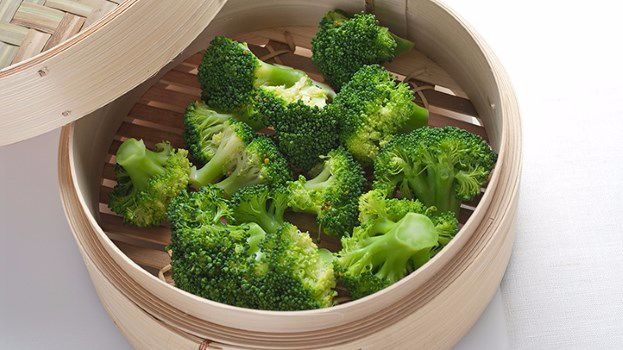Not all food is created equal if prepared the wrong way. See which mistakes you could be making with some of your favorites.

Steaming was the only cooking method that completely preserved, and even increased, the cancer fighting components of broccoli.
Imagine the following scenario. You're engaged in conversation at a dinner party with friends that you feel comfortable enough to discuss "hot button" topics with. Politics, religion, and parenting techniques probably come up and most likely, the views vary by person. When I attend dinner parties, however, the issue of food is often the hot topic of the night, and even hotter, the opinions surrounding the right and wrong way to eat. It's not enough these days that we are eating more kale (thank you trendy farmers markets and Hollywood celebrities!), we have to now dissect the right and wrong way to eat it as well. It was discussions like these that motivated me to write this blog. After all, my career surrounds helping people to simply eat better -- to get, what I call, the most bang for their nutritional buck. There are many factors that impact the amount of nutrients that you will derive from a food. Things such as cooking and ripening method, food pairing and even your owngut flora may impact how much benefit you get from plant-based foods. Different varieties of foods affect this as well. Not all nuts, apples or as you'll read in my first example, potatoes are created equal. If you're interested in knowing how science views the best way to eat, then read on. Spoiler alert: Raw is not always the right way to go!
Potatoes
Think you're getting the benefits of the potato vegetable when you consume French fries, mashed or baked potatoes from white potatoes? Think again! One study found that it was purple potatoes that gave the best benefits, like lowering blood pressure and reducing the risk for cancer. Further, a 2014 study found that purple potatoes surpassed their white counterparts when it came to high amounts of polyphenols and decreased effect on overall blood sugar response.
Carrots
As fall gears up, our love of soup increases as well. Next time you're making a batch of chicken noodle soup, resist the urge to cut up your carrots. One studyfound that cutting carrots increased surface size and allowed more nutrients to leach out. That means after washing and peeling, your carrots should hit the water in their whole form. Keep cooking (vs. raw) though. One study found that cooking carrots increased the bioavailability of carotenoids.
Tea
If you want high nutrient absorption with your high tea, then forget about doing as the Brits do it! Several studies have shown that adding milk to your tea may actually take away some of the cardiovascular benefits that tea provide. Going with green tea? Add a little juice instead to sweeten. The vitamin C in juice may help to increase the bioavailability of green tea's nutrients.
Garlic
Don't rush your garlic, CRUSH your garlic! Research indicates that crushing your garlic and allowing to sit for at least ten minutes released an enzyme called allicin that has been shown to help reduce the risk of cardiovascular disease by making platelets less sticky or more likely to flow freely through the cardiovascular system.
Salad dressing
Fat free dressing may seem like a good idea in theory, but when you look at what you give up; it's no match for the full fat counterpart. Several studies have shown the benefits that fat has when dressing your greens, from keeping you fuller and more satisfied after consumption to getting more nutrient absolution from your salad (specifically from lutein, lycopene, beta-carotene and zeaxanthin).
Apples & Pears
Let your fruit ripen up a bit! One study found that the ripening process allowed the breakdown of chlorophyll in ripening apples and pears which, in turn, produced more "highly active" antioxidants in the fruit.
Broccoli
Broccoli is, without doubt one of the best foods you can feed your body! Broccoli is part of the brassica family of foods, a family that has shown to be quite effective in terms of prevention of certain cancers from breast cancer to skin cancer , but how you prepare your broccoli makes all the difference in the world. A 2008 study found that steaming was the only cooking method that completely preserved, and even increased, the cancer fighting components of broccoli. Boiling and frying were found to be the worst cooking methods. Still don't want to ditch the boiled broccoli? Pairing with a spicy food may help! A 2012 study found that adding spicy foods to broccoli increased its cancer fighting power and the spicier the better according to the study authors!
Mustard
Mustard in any form is a fabulous condiment to add to sauces, salads and sandwiches, but if you're interested in decreasing overall inflammation as well as reducing your risk for certain cancers then you better keep your mustard choices simple. That's right! It's the cheap yellow mustard options that have the best benefits. Why? Because they contain a compound called curcumin (that's the active ingredient in turmeric) that not only gives cheap yellow mustard its yellow color, but all of its potential health benefits as well!
While the factors discussed in this blog have an impact on the best ways to consume your foods, the truth is, simply adding these foods to your diet is a huge step in the right direction. Once you have mastered a liking for these healthier food options, the next logical step is to prepare in the best way for maximum nutrient density!



